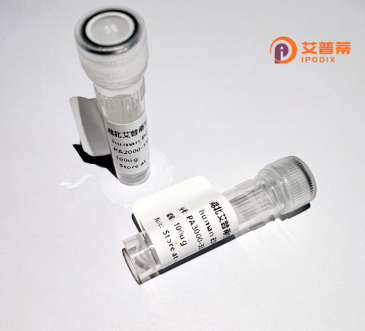
| 纯度 | >90%SDS-PAGE. |
| 种属 | Human |
| 靶点 | B3GNT1 |
| Uniprot No | O43505 |
| 内毒素 | < 0.01EU/μg |
| 表达宿主 | E.coli |
| 表达区间 | 1-415aa |
| 氨基酸序列 | MQMSYAIRCAFYQLLLAALMLVAMLQLLYLSLLSGLHGQEEQDQYFEFFPPSPRSVDQVKAQLRTALASGGVLDASGDYRVYRGLLKTTMDPNDVILATHASVDNLLHLSGLLERWEGPLSVSVFAATKEEAQLATVLAYALSSHCPDMRARVAMHLVCPSRYEAAVPDPREPGEFALLRSCQEVFDKLARVAQPGINYALGTNVSYPNNLLRNLAREGANYALVIDVDMVPSEGLWRGLREMLDQSNQWGGTALVVPAFEIRRARRMPMNKNELVQLYQVGEVRPFYYGLCTPCQAPTNYSRWVNLPEESLLRPAYVVPWQDPWEPFYVAGGKVPTFDERFRQYGFNRISQACELHVAGFDFEVLNEGFLVHKGFKEALKFHPQKEAENQHNKILYRQFKQELKAKYPNSPRRC |
| 分子量 | 47.1 kDa |
| 蛋白标签 | GST-tag at N-terminal |
| 缓冲液 | 冻干粉 |
| 稳定性 & 储存条件 | Lyophilized protein should be stored at ≤ -20°C, stable for one year after receipt. Reconstituted protein solution can be stored at 2-8°C for 2-7 days. Aliquots of reconstituted samples are stable at ≤ -20°C for 3 months. |
| 复溶 | Always centrifuge tubes before opening.Do not mix by vortex or pipetting. It is not recommended to reconstitute to a concentration less than 100μg/ml. Dissolve the lyophilized protein in distilled water. Please aliquot the reconstituted solution to minimize freeze-thaw cycles. |
以下是与重组人N-乙酰乳糖胺β-1.3-N-乙酰葡糖胺转移酶(B3GNT1)相关的3篇文献摘要总结:
1. **文献名称**:*B3GNT1 regulates colonic cancer cell adhesion and modulates metastatic potential*
**作者**:Smith et al.
**摘要**:研究发现B3GNT1在结肠癌细胞中高表达,通过调控细胞表面黏蛋白多聚乳糖胺链的合成,增强肿瘤细胞与内皮细胞的黏附能力,从而促进转移。基因沉默B3GNT1显著抑制小鼠模型中癌细胞扩散。
2. **文献名称**:*B3GNT1 deficiency attenuates allergic airway inflammation via modulating Th2 cytokine production*
**作者**:Li et al.
**摘要**:通过构建B3GNT1基因敲除小鼠模型,发现该酶通过影响T细胞表面糖基化修饰,调控Th2细胞因子(如IL-4和IL-13)的分泌,从而减轻过敏性哮喘症状,揭示其在免疫调节中的关键作用。
3. **文献名称**:*Structural insights into the catalytic mechanism of B3GNT1 in poly-N-acetyllactosamine biosynthesis*
**作者**:Zhang et al.
**摘要**:利用X射线晶体学解析B3GNT1的三维结构,揭示了其底物结合口袋和催化活性位点的关键氨基酸残基,阐明其通过β1-3糖苷键连接N-乙酰葡糖胺与N-乙酰乳糖胺的分子机制,为靶向抑制剂设计提供依据。
以上研究涵盖B3GNT1在肿瘤转移、免疫调节及结构功能领域的核心发现。
B3GNT1 (β-1.3-N-acetylglucosaminyltransferase 1) is a key enzyme in glycobiology, responsible for catalyzing the transfer of N-acetylglucosamine (GlcNAc) from UDP-GlcNAc to β-galactose-terminating glycoconjugates via a β1.3-linkage. This reaction is critical for synthesizing linear poly-N-acetyllactosamine (poly-LacNAc) chains, which are structural backbones of many biologically active glycans. These glycans play essential roles in cellular recognition, immune responses, and signaling pathways.
The human B3GNT1 gene, located on chromosome 11q13.5. encodes a type II transmembrane protein primarily localized to the Golgi apparatus. Dysregulation of B3GNT1 has been linked to diseases such as cancer, inflammation, and neurological disorders. For instance, upregulated B3GNT1 expression is associated with tumor metastasis through enhanced cell adhesion and glycosphingolipid synthesis.
Recombinant B3GNT1 is produced using expression systems (e.g., mammalian or insect cells) to study its enzymatic mechanisms, substrate specificity, and interactions with other glycosyltransferases. Its recombinant form enables biochemical characterization and screening of glycosylation inhibitors. Research also focuses on its role in shaping glycan diversity, impacting pathogen recognition, and modulating therapeutic antibody efficacy. Understanding B3GNT1’s function provides insights into glycan-mediated pathologies and potential biotechnological applications.
×